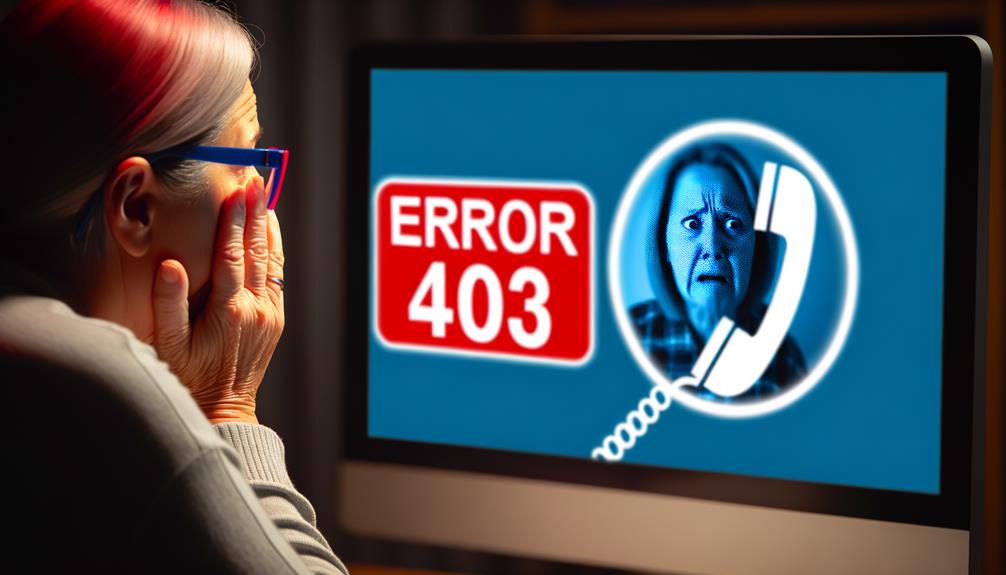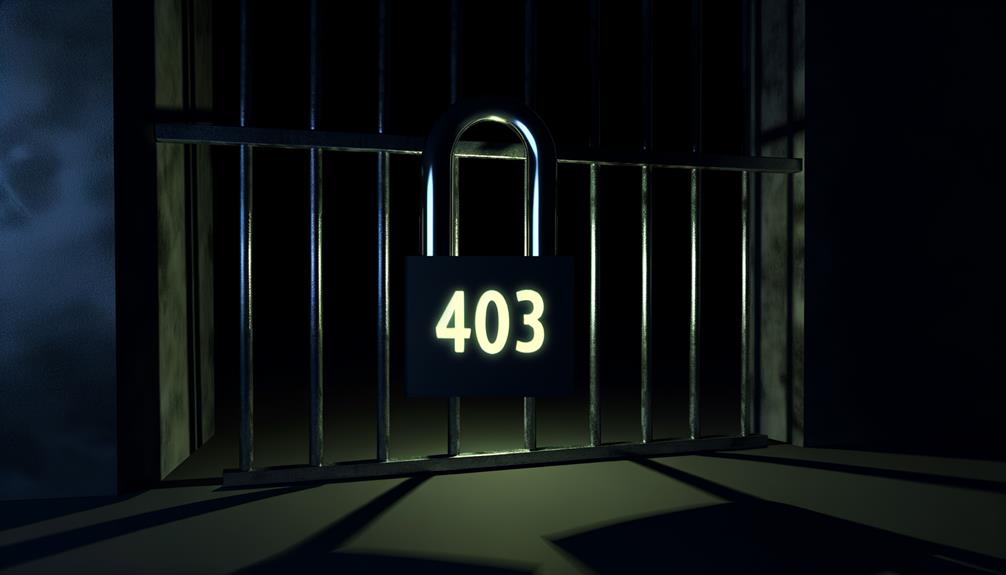Just as a locked door can prevent one from accessing a room, so too can 'Error 403' block one's access to a desired webpage. This error message, a common sight in the world of internet browsing, often leaves users scratching their heads in confusion.
What exactly does 'Error 403' mean? What are its potential causes, and, more importantly, how can it be resolved? And what does it have to do with things like 'proxy servers' and 'browser privacy software'?
Stay tuned to find out.
Key Takeaways
- Error 403 signifies a forbidden request due to invalid browser request or malfunctioning proxy servers.
- Troubleshooting Error 403 involves checking file permissions, inspecting .htaccess file, and examining firewall settings.
- Addressing proxy server issues and managing browser privacy software problems are essential steps in resolving Error 403.
- Contacting support with a detailed explanation and screenshots of the issue ensures a swift resolution to persistent Error 403 issues.
Understanding the Error 403 Message

The Error 403 message, a common yet often misunderstood digital roadblock, indicates an unfulfilled request for a specific URL due to an invalid request received from the browser. Understanding error codes like this one is important for efficient online navigation.
The '403' part of the message, a common browser error, originates from the HTTP status code list, indicating 'Forbidden'. It's often triggered by malfunctioning proxy servers or privacy software, indicating the user's request was legitimate but the server is refusing to respond. This refusal might be due to lack of permission to access the requested resource.
Essentially, Error 403 is the web's way of saying, 'I've received and understood your request, but I won't fulfill it'. Working to understand these codes is a step towards digital liberation.
Steps for Troubleshooting Error 403

When you encounter an Error 403, there are several effective steps you can take to troubleshoot and potentially resolve the issue. Understanding the common causes helps in formulating a solution. It could be due to incorrect file permissions, faulty .htaccess file, or even a misconfigured website firewall.
For troubleshooting techniques, first, check file permissions. Files should be set to 644 or 755. Next, inspect the .htaccess file. Any incorrect rewrite rules can trigger Error 403. If these steps don't rectify the problem, examine the website's firewall settings. Sometimes, overly protective settings can block legitimate traffic, causing the error.
Addressing Proxy Server Issues

Dealing with proxy server issues involves several important steps, including recognizing a malfunctioning server, identifying misconfigured settings, and making sure the server isn't blocking your request. Proxy server troubleshooting can seem challenging, but it's necessary in resolving access issues.
To start, test your connection without the proxy to identify if it's the source of the problem. Then, examine the server's settings. Misconfigurations can often lead to Error 403. Confirm you're not accidentally blocking requests to the desired URL.
If it's still not working, consider reaching out to your network administrator. They can confirm whether the issue lies within the server or elsewhere. Remember, liberation from Error 403 is a systematic process. With patience and attention to detail, these challenges can be overcome.
Managing Browser Privacy Software Problems

Shifting our focus from proxy server issues, it's equally important to note that browser privacy software, too, can contribute to the notorious Error 403. These privacy tools, although designed to protect user data, can sometimes overzealously block a legitimate request. Configuring settings correctly will help manage this issue.
Users should first check their software's settings, ensuring nothing inappropriate is being blocked. If Error 403 persists, disabling privacy extensions temporarily can be a useful diagnostic tool. It's also essential to keep these software up-to-date, as patches often include fixes for known issues.
Properly managing browser privacy software can free users from the shackles of Error 403, paving the way for a liberated, unhindered web experience.
How to Contact Support for Error 403

In the event that Error 403 persists despite all troubleshooting efforts, it's crucial to contact the support team for assistance. Utilizing support communication channels effectively guarantees a swift resolution.
Begin by sending an email to the provided address, including the technical support key. This key aids the support team in diagnosing the issue accurately, forming part of their error resolution strategies.
In your email, outline the problem, detail the troubleshooting steps already taken, and attach any relevant screenshots. This thorough approach enables the support team to grasp the issue immediately, saving time and facilitating quicker resolution.
Once the email is sent, await their response. Remember, patience is key. In the pursuit of liberation from Error 403, support teams are essential allies.
Frequently Asked Questions
What Does Error 403 Mean in Terms of Website Security?
"In website security, a 403 error indicates restricted access. It's impact can deter users, but bypassing 403 errors is possible, often by adjusting privacy settings, disabling proxies, or seeking technical support for resolution."
Could an Error 403 Message Ever Be Due to a Problem With the Website Server, Rather Than the User's Actions or Settings?
Indeed, server maintenance impact or misconfigured permissions on the website server can cause an Error 403 message, not just user's actions or settings. It's not solely a user-side problem.
Are There Any Risks Associated With Disabling My Privacy Software to Resolve Error 403?
Yes, there're risks. Disabling privacy software exposes one's device to potential threats. However, considering privacy software alternatives can help mitigate Error 403 implications without jeopardizing device security. Always tread with caution.
Can I Prevent Error 403 Messages From Appearing in the Future?
To prevent future disruptions, they'll need to focus on permissions management and user authentication. It's critical to regularly update software, monitor settings, and verify permissions to make certain all requests are valid and authorized.
Is There Any Difference in How I Should Address Error 403 if I'm Using a Mobile Device Versus a Desktop Computer?
While addressing error 403, there's no significant difference between mobile and desktop. However, mobile security measures and desktop configuration tips vary, based on device-specific settings and apps. They'd both require proper proxy and privacy settings.
Conclusion
To sum up, understanding the 'Error 403' message and its potential triggers, like a malfunctioning proxy server or privacy software, is important for efficient troubleshooting. Implementing practical solutions such as adjusting browser settings or contacting technical support can alleviate this issue.
Remember, it's important to provide all relevant information to support, including the technical support key. With this guide, moving through 'Error 403' becomes a less intimidating task.

